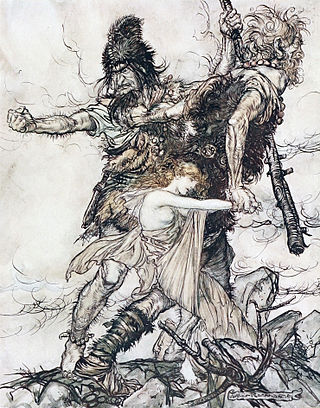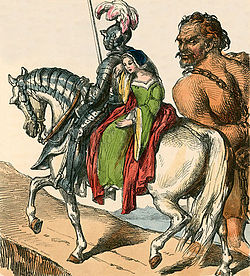
Hampshire is a ceremonial county in South East England. It is bordered by Berkshire to the north, Surrey and West Sussex to the east, the Isle of Wight across the Solent to the south, Dorset to the west, and Wiltshire to the north-west. The cities of Southampton and Portsmouth are the largest settlements, and the county town is the city of Winchester.

King Arthur, according to legends, was a king of Britain. He is a folk hero and a central figure in the medieval literary tradition known as the Matter of Britain.

English mythology is the collection of myths that have emerged throughout the history of England, sometimes being elaborated upon by successive generations, and at other times being rejected and replaced by other explanatory narratives. These narratives consist of folk traditions developed in England after the Norman Conquest, integrated with traditions from Anglo-Saxon mythology, Christian mythology, and Celtic mythology. Elements of the Matter of Britain, Welsh mythology and Cornish mythology which relate directly to England are included, such as the foundation myth of Brutus of Troy and the Arthurian legends, but these are combined with narratives from the Matter of England and traditions from English folklore.

In folklore, giants are beings of humanoid appearance, but are at times prodigious in size and strength or bear an otherwise notable appearance. The word giant is first attested in 1297 from Robert of Gloucester's chronicle. It is derived from the Gigantes of Greek mythology.

Netley Abbey is a ruined late medieval monastery in the village of Netley near Southampton in Hampshire, England. The abbey was founded in 1239 as a house for monks of the austere Cistercian order. Despite royal patronage, Netley was never rich, produced no influential scholars nor churchmen, and its nearly 300-year history was quiet. The monks were best known to their neighbours for the generous hospitality they offered to travellers on land and sea.

Guy of Warwick, or Gui de Warewic, is a legendary English hero of Romance popular in England and France from the 13th to 17th centuries, but now largely forgotten. The story of Sir Guy is considered by scholars to be part of the Matter of England.

Lyndhurst is a large village and civil parish situated in the New Forest National Park in Hampshire, England, about nine miles (14 km) south-west of Southampton. Known as the "Capital of the New Forest", Lyndhurst houses the New Forest District Council and Court of Verderers. It is also a popular tourist attraction, with many independent shops, art galleries, cafés, museums, pubs and hotels. As of 2001 Lyndhurst had a population of 2,973, increasing to 3,029 at the 2011 Census.

Bevis of Hampton (Old French: Beuve(s) or Bueve or Beavisde Hanton(n)e; Anglo-Norman: Boeve de Haumtone; Italian: Buovo d'Antona) or Sir Bevois was a legendary English hero and the subject of Anglo-Norman, Dutch, French, English, Venetian, and other medieval metrical chivalric romances that bear his name. The tale also exists in medieval prose, with translations to Romanian, Russian, Dutch, Irish, Welsh, Old Norse and Yiddish.

Cadnam is a village situated in Hampshire, England, within the boundaries of the New Forest National Park. The village has existed since the medieval period, when it was an important crossroads between Southampton and the towns of Dorset.
Bevis is a given name of Old French origin, meaning someone coming from Beauvais, in the Oise region, or after the Norman French “belfils” or “beufitz”, meaning fair or lovely son. It was not recorded in England until after the Norman Conquest in 1066.

Bramshaw is a small village and civil parish in Hampshire, England. It lies just inside the New Forest. The name Bramshaw means Bramble Wood.
King Horn is a Middle English chivalric romance dating back to the middle of the thirteenth century. It survives in three manuscripts: London, British Library, MS. Harley 2253; Oxford, Bodleian Library, MS. Laud. Misc 108; and Cambridge, Cambridge University Library, MS. Gg. iv. 27. 2. It is thought to be based on the Anglo-Norman Romance of Horn (1170). The story was retold in later romances and ballads, and is considered part of the Matter of England. The poem is currently believed to be the oldest extant romance in Middle English.

Southampton is a port city in Hampshire, England. It is located approximately 80 miles (130 km) southwest of London, 20 miles (32 km) west of Portsmouth, and 20 miles (32 km) southeast of Salisbury. Southampton had a population of 253,651 at the 2011 census, making it one of the most populous cities in southern England.

The Bargate is a Grade I listed medieval gatehouse in the city centre of Southampton, England. Constructed in Norman times as part of the Southampton town walls, it was the main gateway to the city. The building is a scheduled monument, which has served as a temporary exhibition and event space for Southampton Solent University since 2012.

North Stoneham is a settlement between Eastleigh and Southampton in south Hampshire, England. Formerly an ancient estate, manor, and civil parish, it is currently part of the Borough of Eastleigh. Until the nineteenth century, it was a rural community comprising a number of scattered hamlets, including Middle Stoneham, North End, and Bassett Green, and characterised by large areas of woodland.

Sir Henry William Russell Bencraft was an English first-class cricketer, sports administrator, medical doctor, businessman and philanthropist. Bencraft was an important figure in the early history of Hampshire County Cricket Club, overseeing the club from the loss of its first-class status to its reacquisition of that status, both as a player and an administrator. As an administrator, he is credited with saving Hampshire County Cricket Club from extinction in 1880, and later played a role in its reacquisition of first-class status and joining of the County Championship in 1895. Outside of Hampshire cricket, he sat on the committee of the Marylebone Cricket Club, then the governing body of cricket.
Sir Gawain and the Carle of Carlisle is a Middle English tail-rhyme romance of 660 lines, composed in about 1400. A similar story is told in a 17th-century minstrel piece found in the Percy Folio and known as The Carle of Carlisle. These are two of a number of early English poems that feature the Arthurian hero Sir Gawain, the nephew of King Arthur, in his English role as a knight of the Round Table renowned for his valour and, particularly, for his courtesy.
Matter of England, romances of English heroes and romances derived from English legend are terms that 20th century scholars have given to a loose corpus of Medieval literature that in general deals with the locations, characters and themes concerning England, English history, or English cultural mores. It shows some continuity between the poetry and myths of the pre-Norman or "Anglo-Saxon" era of English history as well as themes motifs and plots deriving from English folklore. The term Matter of England was coined in reference to the earlier Three Matters as termed by the French author Jean Bodel; the Matter of Britain, of France and of Rome.

Beves of Hamtoun, also known as Beves of Hampton, Bevis of Hampton or Sir Beues of Hamtoun, is an anonymous Middle English romance of 4620 lines, dating from around the year 1300, which relates the adventures of the English hero Beves in his own country and in the Near East. It is often classified as a Matter of England romance. It is a paraphrase or loose translation of the Anglo-Norman romance Boeuve de Haumton, and belongs to a large family of romances in many languages, including Welsh, Russian and even Yiddish versions, all dealing with the same hero.
The Bevis, also known as the Bevis of Hampton, was a merchant sailing ship that brought "Emigrants" from England to New England in 1638, this at a time when thousands of Puritans left England seeking freedom of religious practice.














